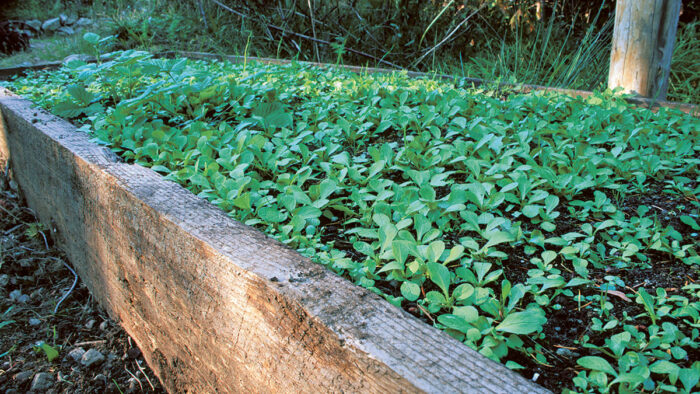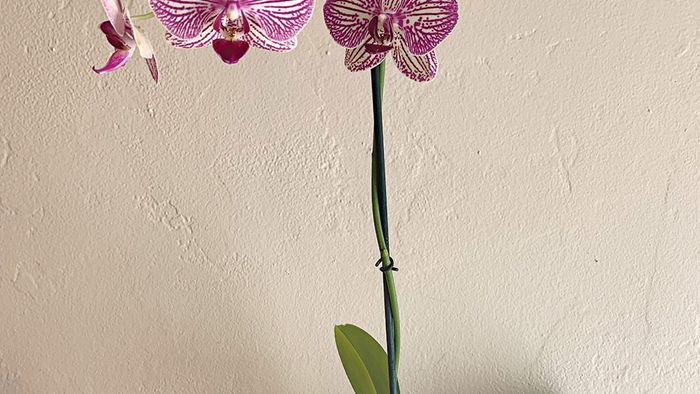
When I was a child, our family celebrated the year’s first garden salad of nutty, dark-green rosettes that we called feldsalat. Back then, my mother had the seeds mailed from Germany. These days, I share my love for those thick, emerald leaves all winter long with my husband, who calls them la mâche. He grew up in France, where this humble weed with its elevated gourmet status graces bistro menus and markets alike.
Found growing wild in grain fields in Europe, la mâche was once available only in early spring. Commercial greenhouses in Europe now supply improved cultivars year-round. In North America, this easy-to-grow green is sometimes called corn salad or lamb’s lettuce.
Mâche has a delicate flavor, which resembles a nutty, concentrated butterhead lettuce. The leaves provide a nutritious boost of vitamins and minerals, especially iron. Producing attractive and tasty fare at a time when little else is available, mâche is a hardy survivor, requiring little care and remaining free of pests and disease.
Choose from small- or large-seeded varieties
About 60 varieties of mâche have been developed from the original wild plant, with differences in leaf size, shape, and flavor. Of these, only a few are available in North America, and fall into two categories: large-seeded and small-seeded.

The large-seeded varieties produce 4- to 8-inch rosettes, with a light green color, and narrow, elongated, spoon-shaped leaves. Highly productive, easy-to-harvest large-seeded cultivars include ‘Grosse Graine’, ‘Piedmont’, and ‘Valgros’.
The small-seeded varieties produce plants 2 to 5 inches in diameter, with rounder and darker-green leaves. Though more finicky to pick and clean, small-seeded choices such as ‘Coquille de Louviers’, ‘D’Etampes’, or ‘Verte de Cambrai’ are definitely more flavorful. In general, large-seeded types resist heat better; small-seeded types prefer cool, moist conditions, and do best when grown only in winter.
Sow seeds around Labor Day
Like many weeds, mâche grows vigorously in almost any soil, although it will produce more foliage with the addition of nitrogen-rich compost or manure. Here in the Pacific Northwest, I generally sow the seeds shortly after the Labor Day weekend. Some seed catalogs recommend planting in spring and then spacing the sowings throughout the summer for a continuous harvest. I find, however, that the seeds germinate poorly and bolt quickly in hot weather. Ideally, seeds should be planted after mid-August, when temperatures are beginning to drop, and before the end of September.
Mâche is remarkably hardy. The only gardeners who must forego this winter treat are those living in zones where the mercury dips below 5°F. A cold frame or mulching with straw or coniferous branches can provide significant protection in colder climates. Alternatively, cold climate gardeners can enjoy a late spring harvest from seed planted as soon as the soil can be worked, in late winter.

To plant in rows, sow three or four seeds per inch, 1 ⁄ 4 inch deep, with the rows about 10 inches apart. Keep the soil moist, until autumn weather takes over this chore.
I prefer to plant in blocks, often covering several empty beds, as mâche makes an excellent green manure and soil conditioner if you turn under what’s left after your harvest. I broadcast the seeds on the soil surface, tamp the soil with a rake or press the bed flat with a board (a level bed facilitates harvesting), and mulch with a sparse layer of hay. Thinning is not necessary, but can mean the difference between a 3-inch and a 6-inch rosette.
Harvest leaves or rosettes
Robust growth in good conditions provides me with the first bowlful of mâche thinnings by late October. In my garden, in British Columbia, plants reach their peak size and flavor in February and March. To harvest, I grasp the plant and cut near the base for whole rosettes, or an inch or two higher for cut-and-come-again leaves. Mâche stores well for up to two weeks in a plastic bag in the refrigerator. Wash it just before serving.

Leaves can be plucked well into April, when the plants bolt to seed; they remain tender, with no hint of bitterness or spice. When the plants are mature, I shake the flower stalks into a paper bag and have no trouble gathering an ample supply of next year’s seed. A light hoeing then turns the remaining stalks and stems into the soil as green manure.

Sources for mâcheIf you’re having trouble locating mâche seeds on these or other Web sites, try searching for “corn salad” or even “greens”. The Cooks Garden Johnny’s Selected Seeds Ornamental Edibles |
—Ingrid Bauer consumes deliciously simple mache salads on Oil Salt Spring Island, British Columbia.
Photos: Janet Jemmott.
February 2000
from Kitchen Gardening #25
Fine Gardening Recommended Products

The New Organic Grower, 3rd Edition: A Master's Manual of Tools and Techniques for the Home and Market Gardener, 30th Anniversary Edition
Fine Gardening receives a commission for items purchased through links on this site, including Amazon Associates and other affiliate advertising programs.

A.M. Leonard Deluxe Soil Knife & Leather Sheath Combo
Fine Gardening receives a commission for items purchased through links on this site, including Amazon Associates and other affiliate advertising programs.

Berry & Bird Rabbiting Spade, Trenching Shovel
Fine Gardening receives a commission for items purchased through links on this site, including Amazon Associates and other affiliate advertising programs.


















Comments
Log in or create an account to post a comment.
Sign up Log in